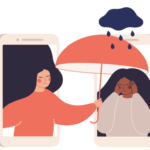 I couldn’t help but roll my eyes. I was at a mandatory “training session” on patient communication for all clinicians at my institution. There, I was being coached on how to properly talk to patients. In theory, this isn’t a bad thing—we all need more education on how to facilitate inclusive and equitable conversations with patients.1 But here, I couldn’t help but feel a sense that I was being manipulated by the institution to improve patient satisfaction numbers by giving an affect of empathy. And this training is not just at my institution; these sessions are becoming increasingly commonplace in hospitals and clinics throughout the U.S. and the world.
I couldn’t help but roll my eyes. I was at a mandatory “training session” on patient communication for all clinicians at my institution. There, I was being coached on how to properly talk to patients. In theory, this isn’t a bad thing—we all need more education on how to facilitate inclusive and equitable conversations with patients.1 But here, I couldn’t help but feel a sense that I was being manipulated by the institution to improve patient satisfaction numbers by giving an affect of empathy. And this training is not just at my institution; these sessions are becoming increasingly commonplace in hospitals and clinics throughout the U.S. and the world.
Anyway, five long hours later—full of mandatory reflections, fun role-playing skits and team-building activities—I left with a greater curiosity about the patient-clinician relationship and the role of empathy in fostering it. Although it wasn’t the intended message, the one thing I learned during my five hours is that the American healthcare system is prompting us to commoditize empathy to improve revenue and profits. This is, needless to say, a very dangerous development.
So how can we, as clinicians, maintain and build our therapeutic alliances with patients based on the core principles of compassion and empathy? Let’s rheuminate.
Empathy vs. Sympathy
A lot has been written about empathy—and just like any other literature, there is a lot of rigorous evidence and theory, and there is a lot of less than high-quality literature.2 Studying a concept like empathy, which is enormously subjective, from a scientific standpoint becomes a slippery slope.3 Worse yet is that empathy is often confused for other, related concepts, such as sympathy and compassion. Sympathy reflects “feelings of pity and sorrow for someone’s misfortune,” whereas empathy is “the ability to understand and share the feelings of another.”4,5
With respect to rheumatology, sympathy can come in many forms. A recognition of the impact of pain or disability may drive a sense of sympathy. But this sympathy can be paternalistic and misguided. After all, the experience of chronic illness is not really a misfortune—the term is stigmatizing and disempowering. Sympathy may also compel us to do things that are not in the patients’ interest, in earnest but potentially harmful attempts to remove that sense of misfortune and make ourselves—but not necessarily the patient—feel better.
This is in contrast to empathy, which doesn’t have that normative aspect of pity or sorrow. As rheumatologists, we can empathize with our patients’ sense of pain and disability as well as with their sense of determination and connectedness to the world. True empathy is much more difficult to experience because it rests on an effort to communicate for understanding. It’s a skill that requires dedicated practice and self-reflection. Empathy is also much more likely to be bidirectional—in that, once we truly empathize with patients, our patients can start to truly empathize with us. In short, empathy is at the heart of a healthy patient-clinician relationship.
It may sound like common sense to you and to me, but that wasn’t what I heard at the mandatory five-hour communication course. Instead, I heard that we need to use certain shortcuts and magical phrases to convince patients of our compassion. Of course, there are no shortcuts in life. What we must do to uphold the patient-clinician relationship is to foster empathy. But if mandatory, five-hour training can’t solve it, how do we do accomplish that?
3 Types of Empathy
The first step is to recognize the different components of empathy. Daniel Goleman and Paul Ekman, two preeminent psychologists, have proposed that there are three components of empathy: cognitive, emotional, and compassionate.6 Before we try to build our empathic skills, perhaps it is important to see how we can advance and balance these three components.
Cognitive Empathy
The first component, cognitive empathy, consists of knowing how the other person feels and what they may be thinking. This kind of perspective taking is highly cerebral and has to be done with intense self-scrutiny. In the rheumatology clinic, we can never really truly know how the other person feels; we can only imagine it based on what they tell us and show us. In the mandatory five-hour communication training, they told us to use a very potent tool of labeling others’ emotions (e.g., “It sounds like it was a painful experience”). Perhaps studies have shown that this improves patient satisfaction scores, but does it really improve our sense of cognitive empathy? I would say no. I would say that there is only one way to develop cognitive empathy and that is through attentive listening.
This listening cannot be the passive listening of turning oneself off and being idle, but rather the active listening of trying to foster bonds and relationships, searching deep within one’s heart to find a sense of affinity.7 All of us have experienced pain but no two painful episodes are alike. But tying one’s own pain to another’s pain is a way to get a glimpse of what they may feel. Even more important is to listen attentively to stories—the narrative structure that frames how we intuitively look at the world around us. Understanding how one aspect of the story links to another and how these plot elements—for lack of a better term—create an emotional resonance is vital.
We are all familiar with the medical process of history taking. It has been part of Medicare’s guidelines.8 Yet history taking is not the correct term to frame our efforts to foster cognitive empathy. Rather, let us start calling it for it is: storytelling. To foster cognitive empathy, let us empower our patients to tell us their stories—uninterrupted. Let’s ditch the clichés, such as “I feel your pain” and “Oh, I can only imagine,” that corporate coaches have reduced to meaninglessness in patient rooms. In storytelling, let’s hear not only about the symptoms, but how the symptoms affected the course of their lives. That way, we can gain perspective and move to the next component of empathy.
Emotional Empathy
This perspective taking is vital for empathic responses, but is insufficient. Emotional empathy must couple with the cognitive element.9 Emotional empathy is the the ability to respond with an appropriate emotion to another’s mental states.
Because human beings are, at their core, social animals, our emotions are contagious and our ability to reciprocate those emotions are a sign of our humanity.10 One day, I had observed one of our fellows instinctively reach for his elbow when a patient mentioned she had elbow pain. It was instinctive and instantaneous, no different than using a reflex hammer to elicit the patellar reflex. In the same way, our facial expressions should express how we process our own emotions based on the patients’ stories.
At the mandatory five-hour training session, they told us to engage in reflecting words. “Patients love that!” the coach exclaimed. But this is only a shallow simulation of emotional empathy. When we hear pain or distress or, alternatively, joy and elation, we shouldn’t think about whether our patient satisfaction scores will increase if we reflect emotions; we should do it because it is what makes us human.
To the instructors’ credit, it’s hard to imagine a way to train people to gain this reflex (in the same way you can’t truly learn to do a knee reflex), but creating environments in which we can practice this, so that it becomes second nature, should be considered an institutional concern.
The intrusive nature of computers within the examination room has done great harm to the cause of providing emotional empathy. It’s hard to imagine a physician truly emoting and connecting with patients while they are on the computer jotting down notes and orders so they can hustle to the next patient on time, although data on this remains mixed.11 Similarly, when physicians are bearing such a high cognitive burden in taking care of patients, it can often be hard to have that instinctive emotional empathy.
That also means prioritizing clinician well-being so we can be in touch with our own emotions. It’s no secret that burnout is endemic among clinicians, and rates have increased in recent years due to structural changes in our healthcare system, as well as stresses placed on clinicians during the pandemic.12 The dehumanization that accompanies burnout can mute our ability to engage in emotional empathy. Unfortunately, no mandatory five-hour training can address that (and neither can free pizza).
Compassionate Empathy
The last form of empathy is perhaps the most contestable. Compassionate empathy is a drive to help others.13 It’s an altruistic trait that inextricably ties the patient and the clinician to one another in a meaningful way. Compassionate empathy is a transcendence of the transactional nature—that a patient is more than a 99215 CPT code or a 30-minute return slot. It’s the impulse that what we are doing has a significant and very real impact on one another.
As with everything else, compassionate empathy rests on harmony with emotional and cognitive empathy. In the rheumatology clinic, compassionate empathy tethers us to the therapeutic nature of our interventions. After all, we don’t prescribe immune modulators to reduce ESR and CRP levels but do so out of a desire to improve the longevity and the quality of life of our patients.
There wasn’t much discussed about compassionate empathy at the mandatory five-hour patient communication course, presumably because the end point wasn’t about compassionate empathy. After all, the ultimate principle driver of these sorts of re-education sessions is about improving patient satisfaction numbers and, ultimately, compensation and money.
Regardless, it’s important to have that compassionate empathy with patients because it centers our actions toward well-being for both patients and clinicians. Having longitudinal contact and seeing the impacts of care can help to further support a practice of compassionate empathy. I would also like to believe that compassionate empathy is a mundane, but nevertheless radical, act of defiance against a heavily corporatized healthcare system.
Social Empathy
While cognitive empathy, emotional empathy, and compassionate empathy are three components of empathy in a very commonly used framework to understand empathy, they aren’t the only components. A more recently articulated form of empathy is social empathy—“the ability to more deeply understand people by perceiving or experiencing their life situations and as a result gain insight into structural inequalities and disparities.”14
Rheumatologists have a unique role in developing this sort of social empathy. Our patients are disproportionately from marginalized and minoritized communities, and an increasing body of evidence demonstrates that immune dysfunction is linked to various socioeconomic determinants of health.15,16 Gaining insight into these inequalities and disparities is a major aspect of being a good rheumatologist, and at every encounter, we should be gaining more and more insights into how our clinical practice interacts with the larger world.
Putting it together, these three components of empathy, plus social empathy, are essential for clinical practice and for the positive outcomes we seek, including patient satisfaction and personal well-being.
As much as my eyes rolled during that mandatory five-hour session, my eyes were also opened to a fundamental dichotomy of our healthcare system. The healthcare system is a machine that churns tangible revenue while we clinicians are human beings who produce intangible results. Harmonizing the two creates a precarious balance. Patients are the key to swinging the balance toward a humanistic direction.
Rheumatologists and other clinicians must be dedicated to building that sense of empathy within ourselves and within our healthcare systems, not to improve such metrics as patient satisfaction scores or revenue for our institutions, but because it is fundamentally the right thing to do. That certainly is my takeaway from five hours of mandatory training.
 Bharat Kumar, MD, MME, FACP, FAAAAI, RhMSUS, is the director of the rheumatology fellowship training program at the University of Iowa, Iowa City, and the physician editor of The Rheumatologist. Follow him on X @BharatKumarMD.
Bharat Kumar, MD, MME, FACP, FAAAAI, RhMSUS, is the director of the rheumatology fellowship training program at the University of Iowa, Iowa City, and the physician editor of The Rheumatologist. Follow him on X @BharatKumarMD.
References
- Brown JB, Boles M, Mullooly J, et al. Effect of clinician communication skills training on patient satisfaction. A randomized, controlled trial. Ann Intern Med. 1999;131(11):822–829.
- Nembhard IM, David G, Ezzeddine I, et al. A systematic review of research on empathy in health care. Health Serv Res. 2023 Apr;58(2):250–263. doi: 10.1111/1475-6773.14016. Epub 2022 Jul 15.
- Sinclair S, Beamer K, Hack TF, et al. Sympathy, empathy, and compassion: A grounded theory study of palliative care patients’ understandings, experiences, and preferences. Palliat Med. 2017 May;31(5):437–447. doi: 10.1177/0269216316663499. Epub 2016 Aug 17.
- Sympathy noun—Definition, pictures, pronunciation and usage notes. Oxford Advanced American Dictionary. OxfordLearnersDictionaries.com.
- Empathy noun—Definition, pictures, pronunciation and usage notes. Oxford Advanced American Dictionary. OxfordLearnersDictionaries.com.
- Raina R. Moving crisis to opportunities: A corporate perspective on the impact of compassionate empathic behaviour on the well-being of employees. JGBC. 2022;17(2):239–255.
- Jahromi VK, Tabatabaee SS, Abdar ZE, Rajabi M. Active listening: The key of successful communication in hospital managers. Electron Physician. 2016 Mar 25;8(3):2123–2128.
- Flugelman MY. History-taking revisited: Simple techniques to foster patient collaboration, improve data attainment, and establish trust with the patient. GMS J Med Educ. 2021 Sep 15;38(6):Doc109.
- Riess H. The science of empathy. J Patient Exp. 2017 Jun;4(2):74–77.
- Herrando C, Constantinides E. Emotional contagion: A brief overview and future directions. Front Psychol. 2021 Jul 16;12:712606.
- Frankel R, Altschuler A, George S, et al. Effects of exam-room computing on clinician-patient communication: A longitudinal qualitative study. J Gen Intern Med. 2005 Aug;20(8):677–682.
- Wisniewska I, Richard Holt G. Burnout in academic medicine: A peripandemic assessment. Perm J. 2023 Jun 15;27(2):150–159.
- Challita M. From empathic mind to moral behaviour: The ‘who,’ ‘why’ and ‘how.’ Med Health Care Philos. 2016 Dec;19(4):517–522.
- Klim G, Boyd KC, Roberts L, Taylor EJ. Social empathy and associated factors among nurses: An observational study. Holist Nurs Pract. 2023 Jan–Feb 01;37(1):6–14.
- Yip K, Navarro-Millán I. Racial, ethnic, and healthcare disparities in rheumatoid arthritis. Curr Opin Rheumatol. 2021 Mar 1;33(2):117–121.
- Williams JN, Drenkard C, Lim SS. The impact of social determinants of health on the presentation, management and outcomes of systemic lupus erythematosus. Rheumatology (Oxford). 2023 Mar 29;62(Suppl 1):i10–i14.


